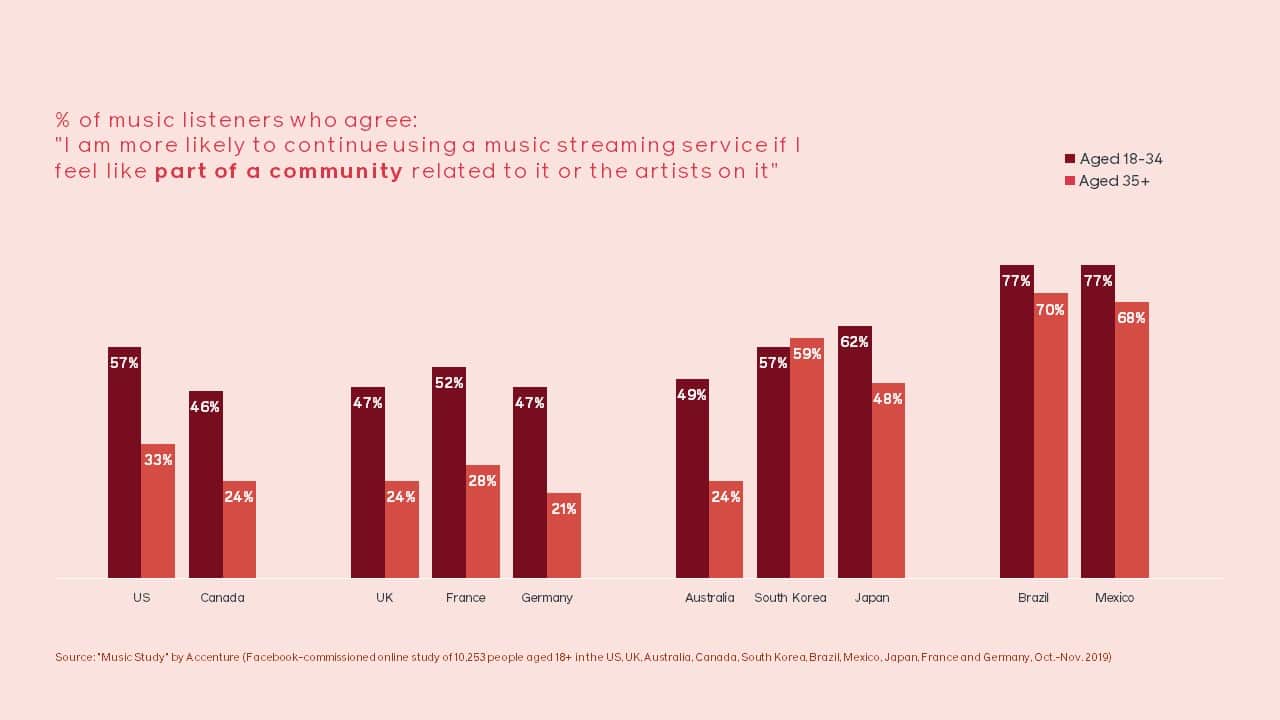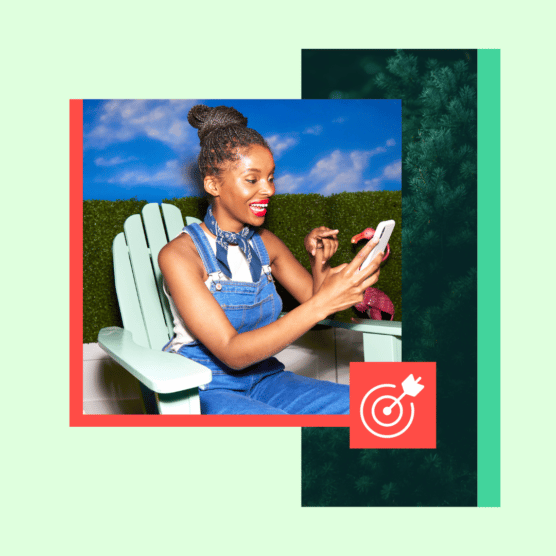Social media for big companies has become about as commonplace as human resource departments.
Unless you’re Apple, you’re on social media. Even the tech giant, which abstained from traditional social media marketing for light-years by Internet standards, now posts regularly across multiple accounts and channels.
Customers take for granted that big companies are on social media. The bigger the company, the higher expectations are that teams sit at the ready to answer questions, put out fires, deliver award-winning creative, and tout corporate values. And frankly, most of those expectations are fair.
Discover how big companies use social media to meet—and in many cases exceed—customer expectations.
Bonus: Get a free social media strategy template to quickly and easily plan your own strategy. Also use it to track results and present the plan to your boss, teammates, and clients.
Social media for enterprise-level businesses is an enterprise unto itself.
A large multinational often operates several social channels in different regions and languages. Depending on the industry, companies may also run separate accounts for support, marketing, different verticals, divisions, and even recruitment.
Just type Disney into a social platform’s search bar and see how many results come up.
These operations involve large teams, multiple agencies, legal oversight, and enterprise-scale management tools, such as Hootsuite Enterprise. To maintain consistent brand voice and messaging across every platform, companies rely on social media style guides, social media guidelines, and social media policies.
These are some of the key goals for big companies on social media:
Increase brand awareness
Big B2C (business to consumer) companies may already benefit from brand name recognition. But social media allows them to increase awareness for specific messages, campaigns, product launches, and other initiatives.
Norwegian Air, for example, used Facebook and Instagram ads to promote awareness in target regions about specific flight routes it operates.
For business-to-business (B2B) companies, social media can provide a means to boost brand visibility and advertise solutions to potential partners and customers.
Connect with specific audiences
Global businesses reach specific market segments on social media through the use of different platforms and accounts.
Different platforms have different demographics. For example, to reach affluent Chinese consumers, luxury brands were among the first to open WeChat business accounts. To reach the younger crowd, several big brands, including Chipotle and Betty Crocker’s Fruit Gushers, hopped on TikTok.
Segmentation happens within platforms as well. Many enterprises run separate accounts for different regions and audiences. Netflix does both, with Twitter handles specific to each market and several of its shows.
All these looks Deleesa turned out makes me excited for her FINALE GLAM 😍 pic.twitter.com/2uJ4yW5eAv
— The Circle on Netflix (@CircleNetflix) May 1, 2021
Ad targeting is another well-known tactic major brands use to reach the right audience.
Gauge customer sentiment
Customer sentiment can move the needle on everything product development, messaging, and even corporate values.
Direct consumer feedback through polls and surveys is one way to source—save for naming contests, which have given us a boat called Boaty McBoatface and a humpback whale dubbed Mister Splashy Pants.
Athleta community! We’d like to get your opinion on our upcoming Spring designs. Your feedback will help inspire future styles. Share your opinion: https://t.co/vW6uGko2XE
— ATHLETA (@Athleta) May 4, 2021
Social media listening offers brands a way to “read the room,” spot trends, and better understand what people care about. In 2014, IKEA teamed up with Brandwatch to open a Listening Hub. “Listening and learning” has since become the first stage in its value chain.
Social listening also allows brands to show up when it counts. People don’t always tag brands when they talk about them, which is why big brands track keywords in addition to mentions.
Starbucks Delivers! Just download the Uber Eats app or visit https://t.co/FT9Kh0PvhK for availability.
— Starbucks (@Starbucks) January 31, 2021
Provide customer support
Customers look for support on the channels they use. According to a recent Harvard Business Review survey, simply responding to people on social media can have a positive effect. In fact, the study found that customers who received any kind of response from a brand rep were willing to spend more with the company in the future.
https://twitter.com/MMcCunney/status/1388940547923054605
Boost traffic and sales
From social selling to social commerce, social channels are a top source of traffic and sales for large companies.
Social platforms continue to add features to make shopping easier, from social storefronts to livestream telecasts. Livestream shopping generated $449.5 million in sales in a single day in China on July 1, 2020.
https://www.facebook.com/ChinaMarketing/photos/a.834852949860749/3047106798635342/?type=3
Social is also a channel where large companies reward customers with sneak peeks, exclusive deals, promo codes, and early access.
Share corporate communications
Product recalls, tech glitches, responses to social issues, hiring announcements. Social media has become a primary channel for big companies to broadcast comms and PR messages.
Peloton and the U.S. Consumer Product Safety Commission are announcing a voluntary recall of Peloton’s Tread+ and Tread products. For more information and to participate in the recall, visit our #recall page https://t.co/I0h2yrSEyX pic.twitter.com/9zp2QMyH9x
— Peloton (@onepeloton) May 5, 2021
Recruit top professionals
Social recruitment now goes well beyond the LinkedIn job posting. Corporate image matters more than ever to young professionals. For big companies, projecting a positive image is an uphill battle. According to a recent survey by McKinsey, the majority of Gen Zers believe large corporations are less ethical than small businesses.
A 2020 poll by Glassdoor finds that three in four employees job seekers look for employers with a diverse workforce. Spurred by the Black Lives Matter movement, posts about workplace diversity, culture, and issues, have become more common on social media.
Build brand communities
While brand communities have existed long before social media. Now Facebook groups, private accounts, and even branded hashtags provide a means to parlay branded clubs, lifestyles, and relationships into online spaces.
Several studies show that participation in communities can increase brand loyalty. But building trust and consumer confidence is hard to do on your own, which is why influencer marketing plays a big role in enterprise-level social media strategies as well.
What can big companies learn from small businesses?
“Small business” has almost become synonymous with “good business.” Need proof? In a recent earnings call, Facebook execs emphasized their work with small businesses no less than 23 times. Large corporations? Not so much.
People are quicker to support small businesses, especially in light of the pandemic. Most mom-and pop-shops operate under time-honored customer service traditions that big businesses too often forget. Here are a few best practices megacorps should keep top of mind.
Build customer relationships
Everyone cherishes the local barista who remembers their coffee order. Big brands can offer comparable levels of service on social media. Read message history or notes before responding to a customer. For example, it’s helpful to know it’s the fourth time someone has had an issue with a service or if they’re a loyalty program member.
Humanize your brand
It’s easier to connect with a neighbour than a faceless corporation. From marketing to recruiting, people increasingly want to see the faces behind the brand.
This extends to customer service as well. A Harvard Business Review study found that even something as small as signing a message with a customer service agent’s initials improves customer perception.
Lead with values
From counter donation jars to ethically-sourced menus, the signs of small business ethics are often in plain sight. Global enterprises have to work a little harder to share corporate values.
Recent research from the University of Toronto reveals that people make judgement calls about a business based on its size. At the same time, consumers increasingly aim to align purchase decisions with values. As a result, it’s essential that big business positions are clear, upfront, and honest.
“Make sure that the story you tell about your brand is true to your business and considers your customers’ expectations,” recommends Pankaj Aggarwal, U of T marketing professor and co-author of the report.
Give back to the community
People shop local to support their community. Multinationals, on the other hand, have a reputation for being exploitative. Nearly half of the global companies assessed in the 2020 Corporate Human Rights Benchmark fail to uphold the United Nations human rights standards.
Social media is one place for corporations that do give back to communities they benefit from to separate themselves from those that don’t. Global brands should share how they invest in the consumer’s community and/or the communities they operate in.
Some big name brands consistently earn top marks on social, from RedBull to Oreo, Lululemon to Nike, and KLM to KFC. The following big brands should also be on your radar.
Patagonia
This private-owned outdoor apparel brand doesn’t make coats for the sake of selling coats. And it doesn’t market for the sake of marketing, as evidenced by its boycott of Facebook ads last year.
“Action is the value that really underpins all the work that we do and certainly all of the marketing work that we do,” said Alex Weller, the brand’s marketing director at the 2020 MAD//Fest. Instead of call-to-actions, Patagonia inspires by showcasing the actions it and others take to protect the planet through long-form content and panoramic visuals.
With this approach, Patagonia attaches more value to its vests than wind flaps moisture-wicking fleece ever could. Instead of apparel, its marketing sells membership in a club committed to environmental action.
Key takeaways
- Don’t market for the sake of marketing. Back your message with purpose.
- Build communities around shared values.
Sephora
Sephora has always been all-in on social media. Last year the beauty brand partnered with Instagram to open a social storefront, complete with loyalty program integration.
Last year, allegations of racial bias and criticism for lack of diversity prompted Sephora to launch an investigation and develop an action plan. Published in November, the report addresses marketing head-on: “Limited racial diversity across marketing, merchandise, and retail employees results in exclusionary treatment.”
The company pledged to ratify this inequity by developing marketing guidelines with a focus on representation and diversity across marketing and products. It also plans to build on its 15% Pledge commitment by supporting and uplifting Black-owned businesses, including through its Accelerate Bootcamp, which is 100% BIPOC this year.
Cultivating diversity will also be part of this year’s edition of #SephoraSquad, an in-house creator program that taps and embraces the power of influencer marketing. First launched in 2019, the “influencer incubator” brings “unique, unfiltered, sorry-not-sorry storytellers,” directly under the company’s wing.
It’s already reaped some of the rewards of inclusive marketing. The company’s Color Under the Lights campaign led to an 8% lift in purchase intent and brand favourability.
Key takeaways:
- Own mistakes and address criticism head-on
- Inclusive marketing has far-reaching benefits
Spotify
Some see Spotify as a social channel in its own right, and that’s not too far off. Along with adding a Stories feature to the app last year, the company also acquired Locker Room in a bid to compete with Clubhouse in the live audio space.
Social is more than a marketing channel for Spotify, it’s baked into the app. In contrast to Apple Music, Spotify makes it easy for people to connect with friends and artists on the platform. Artist profiles include links to social channels, and the platform’s integration with Facebook, Instagram, Snapchat, Whatsapp, Twitter, and other sites is designed to make sharing and promoting music seamless.
Source: Spotify
Spotify meets people where they want to discover music. “For younger generations that have grown up with social media, their music journey begins with social media, where they find themselves discovering music,” said Will Page, former chief economist at Spotify in a recent Facebook study.
Source: Facebook
Another way Spotify excels on social? It lets others do social marketing for them. Tools like Promo Cards and initiatives like the year-end Spotify Wrapped campaign turn artists into influencers and listeners into brand ambassadors.
https://twitter.com/btschartdata/status/1333930585111322626
Key takeaways
- Meet your audience where they’re most receptive
- Provide your community with the tools they need to become ambassadors
Ben & Jerrys
Despite qualifying as a large company, this Vermont-based ice cream-maker has always had the air of a local shop, and its social media presence is no different.
While known for original, chunky flavours, what separates Ben & Jerry’s from the competition is the company’s values. “Many years ago, [co-founder] Ben [Cohen] had this insight that the strongest bond you can create with customers is around a shared set of values,” Christopher Miller, the company’s head of global activism strategy,” tells Harvard Business Review. “We do make a great ice cream. But what drives the loyalty and love for this brand are the things that we believe.”
On social media, the company takes firm positions on public issues, with quick responses that show the pipeline between execs and social managers is short. There’s little sense that messages have been sanitized by overzealous PR teams. Nor do they read like greenwashing or slacktivism. Crucially, the B Corp-certified brand also walks the walk.
While polarizing, Ben & Jerry’s approach is a calculated risk. “ All businesses are collections of people with values; it’s a force that’s always there,” says CEO Matthew McCarthy in the same HBR interview. “I believe that increasingly, in a world of hyper-transparency, if you’re not making your values known publicly, you’re putting your business and brand at risk.”
Key takeaways
- Be transparent. People appreciate honesty.
- Walk the walk. Cause marketing should be supported by action.
Ocean Spray
Blink and you’ll miss some Internet trends—especially those that take place on TikTok. Ocean Spray did not have an official presence on TikTok when Nathan Apodaca posted the now-famous clip of his skateboard commute to work, cran-raspberry juice in hand. Despite the 90-year-old beverage brand’s absence from the platform, the video was on its digital team’s radar within a few days.
Instead of missing the opportunity, Ocean Spray rolled with its viral moment. “We didn’t make an entire marketing model and assessment,” Christina Ferzli, Ocean Spray’s head of Global Corporate Affairs and Communication told Entrepreneur. “ We just tried really quickly to join the conversation.”
In short time, the company’s CEO Tom Hayes skateboarded his way onto the app to recreate the meme. In an expression of gratitude, the company surprised Apodaca with a truckload of cran-raspberry juice and a truck to replace his broken-down car.
@tomhayes603 Did we just become best friends? @mickfleetwood @420doggface208
Key takeaways:
- Social listening allows brands to quickly identify viral moments
- Buy-in from management lets brands seize social opportunities
Execute your enterprise social media strategy efficiently and smoothly with Hootsuite. From a single dashboard you can publish and schedule posts, create team workflows, manage customer support requests, measure performance across channels, and more. Try it free today.
Manage all your social media in one place, measure ROI, and save time with Hootsuite.
Book a Demo




